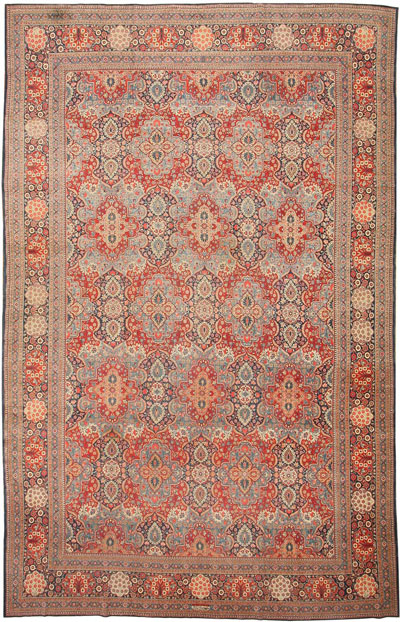Guide to Kashan Rugs, Antique Persian Carpets

Although carpets are known to have been made in Kashan since at least the Sassanian Empire, 224 to 642 CE, there are two major periods of carpet production. The first was during the Safavid period in the sixteenth and seventeenth centuries in royal workshops and commercial weaving centers. The second was during the late nineteenth and early twentieth centuries under Qajar rule, primarily for export but also for use by the Persian upper class.
Classic Kashan rugs feature an elongated central medallion with a fully-covered field and corner spandrels. Colors tend to be bright, with fields of blue, red and ivory. Motifs are densely woven, perhaps the most dense of all the carpet styles. Other styles include all-over patterns with boteh, repeats of floral motifs and vase designs. Borders are often stylized floral motifs of palmettes, tulips, rosettes, vines, scrolls and leaves with a central border flanked by two smaller contrasting bands.
The Safavid period is renowned for artistic expression in architecture, manuscript illumination and calligraphy. Detailing on domes and walls of mosques, public buildings and private houses brought a pleasing aesthetic into the interiors, creating a world of gardens, light and sparkling fountains in sharp contrast to the sometimes harsh environment outside. A refreshing interior provided sanctuary from these elements.
Safavid ruler Shah Abbas (1571-1629) established the Bagh-e Fin Gardens in Kashan, a spring-fed retreat that brought visual delight and cool relief to the user. These gardens still exist today, nominated as a World Heritage Site. The artistic and cultural conventions of that period were expressed in the weaving of carpets, so the feet walked across lush gardens and the eyes relished bubbling fountains indoors.
Kahsan weaving uses the asymmetrical or Persian knot. Safavid-period Kashan carpets were often silk, with gold and silver threads woven into the designs. Animal scenes and gardens were popular themes.
In the later period, warp and weft were usually cotton. Double wefts create an effect of depressed knots. Pile is usually wool, but silk is also seen. Kashan carpets generally have a high knot count. Prayer carpets were popular during the later period, as were pictorial carpets.
Very fine Manchester wool from Britain, also called Merino wool, was used in the late nineteenth and first quarter of the twentieth century in Kashan carpets. When the wool market collapsed at the onset of the Great Depression, weavers switched to local wools. The quality of Manchester wool allowed a higher knot count and well-executed, crisp motifs in a lustrous carpet with a high pile.
A finely-woven type of carpet, called Mohtashem, was produced in the late 1800s and early 1900s. Experts debate whether Mohtashem carpets are the product of a particular workshop or a type produced locally by several weaving centers. Cecil Edwards, representative of the Oriental Carpet Manufacturers in the early 1900s, attributed them to Haj Mullah Hassan, a merchant in the wool trade in the 1890s who married a woman from Arak. When the clothing market collapsed, his wife is said to have used the Manchester wool to make carpets with characteristics of the Sarouk style and a knot count often between 200 and 400 knots per square inch. The border of tulip and blossom found on many Mohatshem carpets resembles older Arak rugs, as does the use of lavender in the selvage. Some carpets are signed as Mohtashem, adding credence to the idea that they were from a single


Find the affordable Relocation Company for Local Office, Apartment, House Moves, Carpet Cleaning services in Dallas, Arlington, Texas at JNLMoving.com. Click Here
ReplyDelete